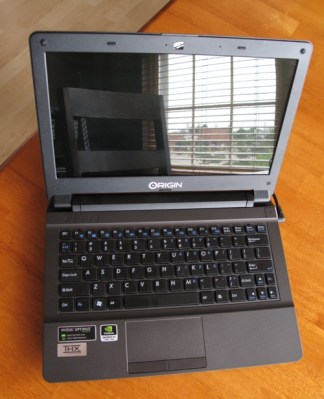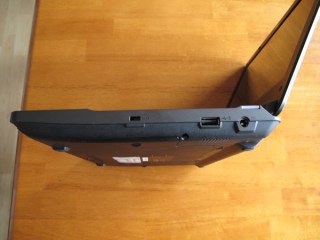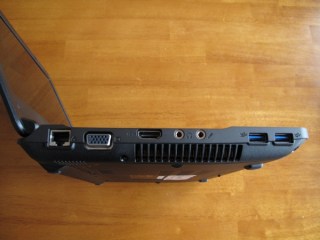A couple years ago, 11-inch laptop gaming was all the rage. Dell led the charge with the Alienware M11x, a netbook-style 11.6-inch laptop that weighed just 4.5 pounds, featured surprisingly high-end gaming specs, and was updated with newer processors and mobile GPUs over the years.
The laptop was reportedly a big success, and why wouldn’t it be? Its Core i5 or i7 processor and Nvidia GeForce 540M graphics offered the option to play games like The Elder Scrolls V: Skyrim or Call of Duty: Black Ops 2 at medium detail levels without dropping below 30 frames per second. You could even find the M11x on big-name retailer store shelves, where it actually looked like an extraterrestrial invader, its red-backlit frame and keyboard at odds with the dozens of comparably mundane-looking, business-angled netbooks.
But Dell recently told The Verge it was phasing out the 11-inch Alienware M11x gaming laptop because its customers were “demanding full-sized keyboards and optical drives” in their gaming rigs. If the part about “optical drives” sounds odd to you, it should: PC gaming, of all things, is the least likely to involve disc-based content delivery at this point. Walk into any retailer that carries PC games in the U.S. — the handful of mainstream-only titles still stocked, that is, tucked away on single shelves or endcaps — as proof of this. The behind-the-scenes reason for Dell’s departure from the 11-inch scene? Anyone’s guess.
Leave it to Origin PC then, a Miami-based company founded by a bunch of former Alienware employees, to throw down its own 11-inch gaming gauntlet with a laptop that frankly blows Dell’s current (and final) 11-inch system out of the water.
Meet the EON11-S
The 11.6-inch EON11-S is actually a rebranded version of Clevo’s W110ER, so when you’re buying from a reseller like Origin PC, you’re basically getting the company’s support/service reputation and design extras, like: 24 x 7 tech support performed in the U.S., Origin’s logo painted on the lid and the company name just below the screen, custom panels and paint jobs (optional), a 72-hour test and “burn-in” period before the system ships and special install options (say you want the machine without an operating system, or with a game pre-installed).
Like the W110ER, the EON11-S includes an 11.6-inch 1366 x 768 pixel LED-backlit glossy LCD screen, an optional B960 Pentium, dual-core Intel Core i5 or quad-core Intel Core i7 CPU, up to 16GB of DDR3 system memory, an Nvidia GeForce GT 650M GPU with 2GB of GDDR3 memory, a 1.3-megapixel camera, up to 1TB spindle-based or 512GB solid state hard drive, 802.11n Wi-Fi and Bluetooth, Ethernet, one USB 2.0 and two USB 3.0 ports, VGA-out, HDMI-out, a 9-in-1 media card reader, a 6-cell Li-Ion battery (rated for up to 6.5 hours), and both an audio-out and microphone jack. The base price: $999.
 My review unit came equipped with a new Ivy Bridge-based quad-core Intel Core i7-3720QM and 6MB of L3 cache, running at 2.6GHz and capable of turbo-boosting to 3.6GHz. The Core i7-3720QM is the second most powerful CPU Origin offers in the EON11-S — a 100MHz step down from the Core i7-3820QM (which probably isn’t worth the upgrade for $220 more).
My review unit came equipped with a new Ivy Bridge-based quad-core Intel Core i7-3720QM and 6MB of L3 cache, running at 2.6GHz and capable of turbo-boosting to 3.6GHz. The Core i7-3720QM is the second most powerful CPU Origin offers in the EON11-S — a 100MHz step down from the Core i7-3820QM (which probably isn’t worth the upgrade for $220 more).
The system also came configured with 8GB of DDR3 system memory and a Samsung 256GB solid state drive — a modestly priced $114 upgrade from the EON11-S’s baseline 320GB 7,200-RPM hard drive. It shipped in a medium-sized box, freestanding but surprisingly well-secured between two pieces of stretched, reinforced plastic and a piece of styrofoam padding. Included in the box: the 120-watt AC adapter, a small box containing the driver disc, a foldout “quick guide,” the manual, an image restore disc, a Windows PE system recovery disc, the operating system disc and an Origin PC t-shirt.
Since the EON11-S doesn’t comes with an integrated optical drive, Origin sent me a Samsung portable DVD writer, which it sells for $40 (you can opt for a Blu-ray writer sans playback software for $121), and I tested using the 64-bit version of Windows 7 Home Premium.
The EON11-S as configured runs $1,481 ($1,521 with the external DVD drive), which is in line with pricing for a comparably configured Clevo W110ER, but much better-priced than Dell’s Alienware M11x equipped with the same memory and hard drive specs though much slower Intel Core i7 2637M 1.7GHz (2.8GHz turbo boost) processor and Nvidia GeForce GT 540M (w/2GB) graphics card — that version of the M11x goes for $1,628.
Weight and Design
The EON11-S isn’t as slender as something like Apple‘s new ultra-high-definition MacBook Pro (which can be configured with the same processors and graphics card), but it’s relatively light at 3.9 pounds — the Alienware M11x weighs 4.4 pounds, while the new MacBook Pro weighs 4.46 pounds by comparison. The casing appears to be garden variety ABS plastic, but with a textured surface across the wrist-rest area composed of thousands of tiny millimeter-sized squares-within-squares.
 That’s extended across the touchpad, which at first feels like a stylish mistake, but once your fingertips acclimate to the non-smooth glide, it offers very precise pointer control. The keyboard itself is low-key, chiclet-style, with slightly italicized lettering — its only downside: no key backlighting.
That’s extended across the touchpad, which at first feels like a stylish mistake, but once your fingertips acclimate to the non-smooth glide, it offers very precise pointer control. The keyboard itself is low-key, chiclet-style, with slightly italicized lettering — its only downside: no key backlighting.
You can opt for alternative case colors at no additional cost, ranging from a silver glossy finish to either black or red matte finishes, or if you’re feeling spendy, Origin can customize the paint job with either predesigned or custom symbols/finishes for between $149 and $349.
The 11.6-inch LED-backlit LCD screen looks wonderful in low-light situations but does suffer from the usual glare issues, especially in high-daylight areas, given its high-gloss screen (alas, there’s no matte configuration option). The lid itself feels reasonably well-built, with average give if you twist the sides using both hands. The hinge looks and feels very durable, and the screen, which can swing back to about a 135-degree angle, exhibited no looseness during my time with it.
Testing, Testing…
I tested the EON11-S with three games: Diablo III, Battlefield 3 and the updated version of Civilization V: Gods & Kings.
Diablo III doesn’t offer an in-game benchmark tool, so I ran Fraps from Act II’s finale sequence (on Nightmare difficulty) starting in the City of Caldeum to just before the boss fight. Video settings were 1366 x 768 fullscreen, vertical sync disabled, anti-aliasing enabled, texture quality and physics set to “high,” and shadow quality and clutter density set to “medium.” The EON11-S muscled through the action without trouble, averaging a high 71 frames per second.
When the on-screen effects reach their apotheosis — dozens of enemies spawning, serious environmental effects in play and all my rune-modified Demon Hunter skills triggering — the system did briefly hiccup, dropping to 17 frames per second, but recovered seconds later. Playing through portions of all four acts, those drops were rare, and you can count the EOS-11 as more than equipped to handle Blizzard’s action-RPG with bells and whistles enabled.

I ran a similar test in Battlefield 3, racing through the campaign’s opening train level with the default graphics settings: 1366 x 768 fullscreen, texture quality at “ultra,” everything else set to “medium,” vertical sync disabled, motion blur “off,” anisotropic filtering “4x” and ambient occlusion set to “SSAO.” The EON11-S cut through the action smoothly, averaging 54 frames per second, topping out at 79 and hitting bottom with a still very comfortable 39.
For Civilization V: Gods & Kings, I chose to play in “DirectX 10 & 11” mode and tested one of my save games, 196 turns in on a standard-sized “continents” map, with video settings at 1366 x 768 fullscreen, anti-aliasing “off,” vertical sync disabled, high detail strategic view enabled and everything set to “high” except terrain shadow quality and water quality, which were both set to “medium.” Panning around the map and zooming all the way in and out while stepping through several turns, the game averaged a comfortable 55 frames per second, though it did tend to stutter when zoomed all the way out, hitting a low (if playable in a turn-based game) minimum of 16 frames per second.
The minimum frame rates in all three games can naturally be raised by fiddling with the detail settings — I opted for higher-end settings to illustrate the system’s ability to run things smoothly at those levels most of the time.
Some Like It Hot
Given what it’s packing, the EON11-S does tend to warm right up, enough so that you wouldn’t want it in your lap while 3D gaming. The fan vents at system left, and you’ll definitely notice this if you happen to rest your left hand along the laptop’s lefthand side. You’ll also find that the 120-watt AC adapter can get extremely warm, making the EON11-S your friend in the winter, but less than friendly in the summer months with the windows open and 80F ambient.
The good news: The fan isn’t loud enough, even running full-speed, to drown out the EON11-S’s stereo speakers. They’re located beneath the EON11-S on either side, facing down, and capable of more than respectable audio output, albeit lacking — no surprise — in lower frequency oomph.
Battery life was also predictable for a gaming laptop: Leave it idling in Windows mode, nothing intensive running, and you’ll approach the 6.5-hour rating, but don’t look to play 3D games cordless for more than an hour or so.
Conclusion
All told, the EON11-S packs enormous power into a netbook-sized laptop more than capable of standing in for most desktops, gaming on mid to high detail settings, especially if you’re looking for something on-the-go and don’t mind the resolution drop. It’s not quite a desktop replacement…though what netbook is, with limited screen real estate and a tendency to lose the home court performance advantage once you start plugging these things into 1920 x 1080 or higher external displays.
But if you’ve been impatiently waiting for Dell to update its 11-inch Alienware lineup, adding parts capable of crunching the latest high-end games, Origin PC’s EON11-S now has that beat covered, and then some.

